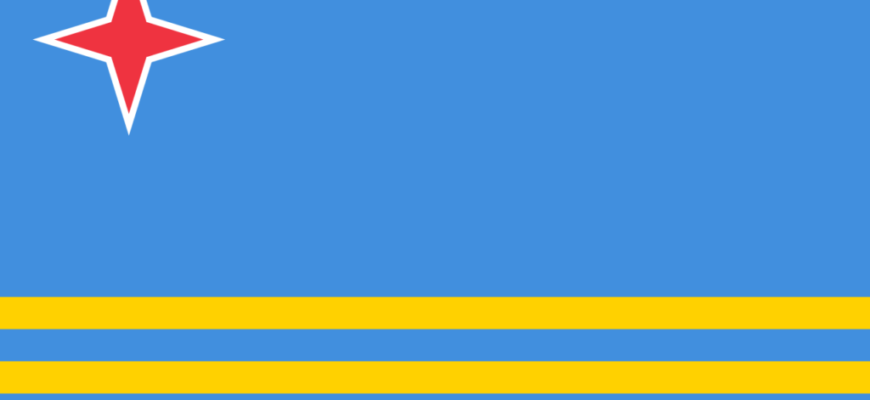The island of Aruba is located 30 km north of Venezuela. Its territory is 190 km2, with a population of 112.3 thousand people. In 1986 it received the status of a self-governing territory within the Kingdom of the Netherlands.
This is what the modern flag of Aruba looks like:

History of the flag
The first Europeans (Spaniards) arrived on the island in the early 16th century, but from the middle of the 17th century the island was taken over by the Dutch, after a 30-year war with Spain.
With the end of World War II, relations between the Netherlands and Aruba were built on the principle of an autonomous state, but the Arubans sought greater freedoms with far-reaching plans, up to and including full independence.
In 1976, Aruba received the first attributes of a state in the form of a flag and an anthem. Its appearance has not changed since then.
Description
The flag of the country has the form of a rectangle with proportions 2:3. The overall background is light blue. At the bottom of the cloth there are two equal horizontal stripes of yellow color. Closer to the staff, at the top of the cloth, a red star is depicted, separated from the rest of the background in white.
Flag colors
The symbolism of the state consists of four colors:
- blue,
- yellow,
- red,
- white.
Meaning of colors and flag symbol
The white border around the star signifies the sandy beaches surrounding the island on all sides.
Aruba’s flag is rich in its symbolism and decipherable:
- The blue background symbolizes the sea, the sky, peace, hope and the future of Aruba;
- The yellow stripes represent the struggle against apartheid, independence. One represents the flow of tourists in Aruba, the other represents all of Aruba’s mineral wealth. In addition, the yellow stripes are a symbol of the Sun and the prosperity of the people.
The star symbol means:
- the island itself (land in red), surrounded by the blue sea and fringed by snow-white beaches;
- the blood shed during the war, as well as the patriotism of the Aruban people and the pernambuco tree;
- The multiplicity of countries from which the country’s population comes (essentially four points of the compass) and the consequent multilingualism of the inhabitants (four languages are used: papiamento, Spanish, English and Dutch).
Interesting! The white line of the star’s border still represents the honesty and purity of the Aruban people’s hearts.
Interesting facts about the flag
Aruba’s governor also has his own symbol.
The light blue field of Aruba’s flag is sometimes called the «color of the UN» because of the similarity in color.
General information about Aruba
| Official language | Dutch and
papiamento |
| Capital | Oranjestad |
| Territory | 178.91 km2 |
| Population | 103 889 people |
| Currency | Aruban florin
(AWG,code 533) |
| Phone Code | +297 |










I remember the first time I saw the Aruba flag waving in the breeze when I visited the island. The vibrant colors just popped against the blue sky! It really captured the warmth and spirit of the place. It’s amazing how a flag can evoke such unforgettable memories.
I remember my trip to Aruba, and seeing that flag waving at the beach made me feel so vibrant! The blue, yellow, and red colors represent the island’s beauty. It’s a small paradise where every sunset feels like a celebration! Can’t wait to go back!
I remember my trip to Aruba last year. Seeing the vibrant Aruba flag waving at the beach filled me with joy. It felt like a symbol of warmth and happiness! I’m so grateful for that experience and can’t wait to go back and soak it all in again!
I remember the first time I saw the Aruba flag at the beach. The vibrant colors reminded me of my adventures on the island. It was such a special trip filled with beautiful memories. I’m so grateful for that experience and the stunning culture of Aruba!
I remember when I visited Aruba and saw the flag waving in the breeze. It was so vibrant! It reminds me of the time I tried snorkeling for the first time. The colorful marine life was just as stunning as the flag. A truly unforgettable experience!